JAJSFC6C May 2015 – April 2018 ADS52J90
PRODUCTION DATA.
- 1 特長
- 2 アプリケーション
- 3 概要
- 4 改訂履歴
- 5 概要(続き)
- 6 Pin Configuration and Functions
-
7 Specifications
- 7.1 Absolute Maximum Ratings
- 7.2 ESD Ratings
- 7.3 Recommended Operating Conditions
- 7.4 Thermal Information
- 7.5 Electrical Characteristics
- 7.6 Digital Characteristics
- 7.7 Timing Requirements: Signal Chain
- 7.8 Timing Requirements: JESD Interface
- 7.9 Timing Requirements: Serial Interface
- 7.10 Typical Characteristics
- 7.11 Typical Characteristics: JESD Interface
- 7.12 Typical Characteristics: Contour Plots
-
8 Detailed Description
- 8.1 Overview
- 8.2 Functional Block Diagrams
- 8.3
Feature Description
- 8.3.1 Connection of the External Inputs to the Input Pins
- 8.3.2 Input Multiplexer and Sampler
- 8.3.3 Analog-to-Digital Converter (ADC)
- 8.3.4 Device Synchronization Using TX_TRIG
- 8.3.5 Digital Processing
- 8.3.6 Data Formatting
- 8.3.7 Serializer and LVDS Interface
- 8.3.8 LVDS Buffers
- 8.3.9 JESD204B Interface
- 8.3.10 Interfacing SYNC~ and SYSREF Between the FPGA and ADCs
- 8.3.11 Clock Input
- 8.3.12 Analog Input and Driving Circuit
- 8.4 Device Functional Modes
- 8.5 Programming
- 9 Application and Implementation
- 10Power Supply Recommendations
- 11Layout
-
12Register Map
- 12.1
ADC Registers
- 12.1.1
Description of Registers
- 12.1.1.1 Register 0h (address = 0h)
- 12.1.1.2 Register 1h (address = 1h)
- 12.1.1.3 Register 2h (address = 2h)
- 12.1.1.4 Register 3h (address = 3h)
- 12.1.1.5 Register 4h (address = 4h)
- 12.1.1.6 Register 5h (address = 5h)
- 12.1.1.7 Register 7h (address = 7h)
- 12.1.1.8 Register 8h (address = 8h)
- 12.1.1.9 Register Ah (address = Ah)
- 12.1.1.10 Register Bh (address = Bh)
- 12.1.1.11 Register Dh (address = Dh)
- 12.1.1.12 Register Eh (address = Eh)
- 12.1.1.13 Register Fh (address = Fh)
- 12.1.1.14 Register 10h (address = 10h)
- 12.1.1.15 Register 11h (address = 11h)
- 12.1.1.16 Register 12h (address = 12h)
- 12.1.1.17 Register 13h (address = 13h)
- 12.1.1.18 Register 14h (address = 14h)
- 12.1.1.19 Register 15h (address = 15h)
- 12.1.1.20 Register 17h (address = 17h)
- 12.1.1.21 Register 18h (address = 18h)
- 12.1.1.22 Register 19h (address = 19h)
- 12.1.1.23 Register 1Ah (address = 1Ah)
- 12.1.1.24 Register 1Bh (address = 1Bh)
- 12.1.1.25 Register 1Ch (address = 1Ch)
- 12.1.1.26 Register 1Dh (address = 1Dh)
- 12.1.1.27 Register 1Eh (address = 1Eh)
- 12.1.1.28 Register 1Fh (address = 1Fh)
- 12.1.1.29 Register 20h (address = 20h)
- 12.1.1.30 Register 21h (offset = 21h)
- 12.1.1.31 Register 23h (register = 23h)
- 12.1.1.32 Register 24h (address = 24h)
- 12.1.1.33 Register 25h (address = 25h)
- 12.1.1.34 Register 26h (address = 26h)
- 12.1.1.35 Register 27h (address = 27h)
- 12.1.1.36 Register 28h (address = 28h)
- 12.1.1.37 Register 29h (address = 29h)
- 12.1.1.38 Register 2Ah (address = 2Ah)
- 12.1.1.39 Register 2Bh (address = 2Bh)
- 12.1.1.40 Register 2Ch (address = 2Ch)
- 12.1.1.41 Register 2Dh (address = 2Dh)
- 12.1.1.42 Register 2Fh (address = 2Fh)
- 12.1.1.43 Register 30h (address = 30h)
- 12.1.1.44 Register 31h (address = 31h)
- 12.1.1.45 Register 32h (address = 32h)
- 12.1.1.46 Register 33h (address = 33h)
- 12.1.1.47 Register 34h (address = 34h)
- 12.1.1.48 Register 35h (address = 35h)
- 12.1.1.49 Register 36h (address = 36h)
- 12.1.1.50 Register 37h (address = 37h)
- 12.1.1.51 Register 38h (address = 38h)
- 12.1.1.52 Register 39h (address = 39h)
- 12.1.1.53 Register 3Bh (address = 3Bh)
- 12.1.1.54 Register 3Ch (address = 3Ch)
- 12.1.1.55 Register 43h (address = 43h)
- 12.1.1
Description of Registers
- 12.2
JESD Serial Interface Registers
- 12.2.1
Description of JESD Serial Interface Registers
- 12.2.1.1 Register 70 (address = 46h)
- 12.2.1.2 Register 73 (address = 49h)
- 12.2.1.3 Register 74 (address = 4Ah)
- 12.2.1.4 Register 75 (address = 4Bh)
- 12.2.1.5 Register 77 (address = 4Dh)
- 12.2.1.6 Register 80 (address = 50h)
- 12.2.1.7 Register 81 (address = 51h)
- 12.2.1.8 Register 82 (address = 52h)
- 12.2.1.9 Register 83 (address = 53h)
- 12.2.1.10 Register 85 (address = 55h)
- 12.2.1.11 Register 115 (address = 73h)
- 12.2.1.12 Register 116 (address = 74h)
- 12.2.1.13 Register 117 (address = 75h)
- 12.2.1.14 Register 118 (address = 76h)
- 12.2.1.15 Register 119 (address = 77h)
- 12.2.1.16 Register 120 (address = 78h)
- 12.2.1.17 Register 134 (address = 86h)
- 12.2.1.18 Register 135 (address = 87h)
- 12.2.1.19 Register 136 (address = 88h)
- 12.2.1.20 Register 137 (address = 89h)
- 12.2.1.21 Register 138 (address = 8Ah)
- 12.2.1
Description of JESD Serial Interface Registers
- 12.1
ADC Registers
- 13デバイスおよびドキュメントのサポート
- 14メカニカル、パッケージ、および注文情報
7.10 Typical Characteristics
At 25°C, AVDD_IP8 = DVDD_1P8 = 1.8 V, and DVDD_1P2 = 1.2 V, unless otherwise noted. All LVDS outputs are active with 100-Ω differential terminations and a 4-pF load capacitor from each LVDS output pin to ground. A –1-dBFS input signal at 5 MHz is applied to the input channel under test. SNR is computed by ignoring the power contained in the first nine harmonic bins, the fS / 2 and fS / 4 frequency bins as well as the bins corresponding to the intermodulation frequencies between the input and the clock. A LVPECL clock is used as the clock source.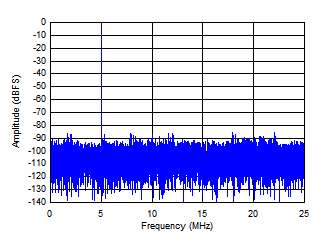
| fIN = 5 MHz, fC = 100 MSPS, SNR = 61.5 dBFS,
SFDR = 81.9 dBc, HD2 = –86.5 dBc, HD3 = –93.9 dBc |
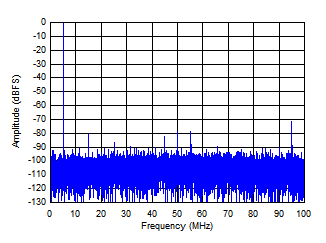
| fIN = 5 MHz, fC = 100 MSPS, SNR = 61.3 dBFS,
SFDR = 70.8 dBc, HD2 = –94.2 dBc, HD3 = –80.1 dBc |
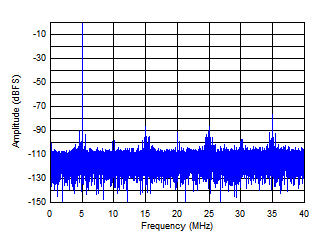
| fIN = 5 MHz, fC = 80 MSPS, SNR = 70.2 dBFS, SFDR = 75.4 dBc, HD2 = –109.8 dBc, HD3 = –86.1 dBc |
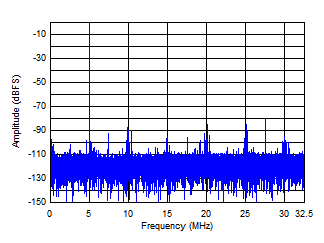
| fIN = 5 MHz, fC = 65 MSPS, SNR = 73.4 dBFS, SFDR = 80.2 dBc, HD2 = –88.7 dBc, HD3 = –93.9 dBc |
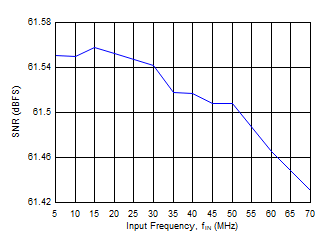
| fSAMP = 100 MSPS |
10-Bit, 16-Input Mode
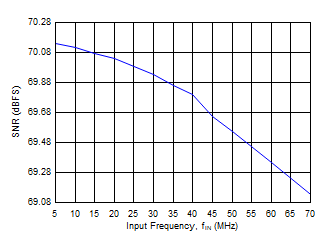
| fSAMP = 40 MSPS |
12-Bit, 32-Input Mode
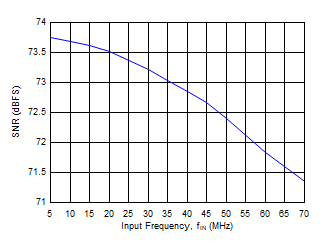
| fSAMP = 32.5 MSPS |
14-Bit, 32-Input Mode
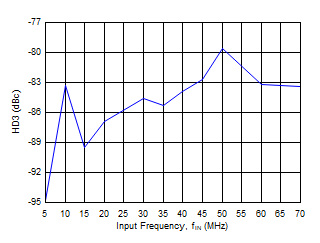
| 100-MSPS conversion clock |
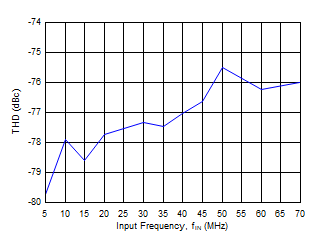
| 100-MSPS conversion clock |
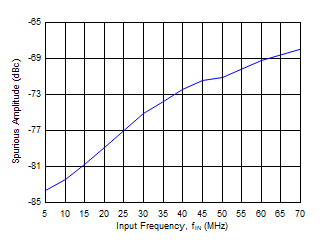
| fSAMP = 100 MSPS |
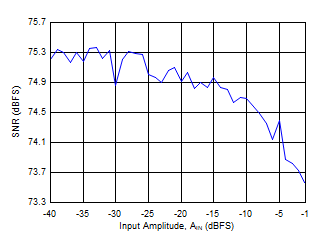
| 16-input mode, 14-bit resolution, fSAMP = 65 MSPS |
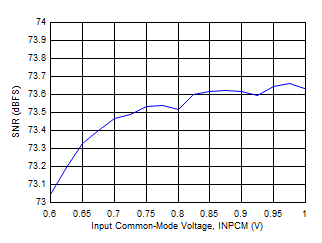
| 16-input mode, 14-bit resolution, fSAMP = 65 MSPS |
Input Common-Mode Voltage (INPCM)
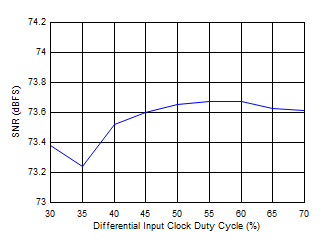
| 16-input mode, 14-bit resolution, fSAMP = 65 MSPS | ||
| space | ||
| space |
Clock Duty Cycle
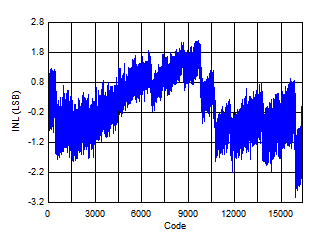
| 32-input mode, 14-bit resolution, fSAMP = 32.5 MSPS |
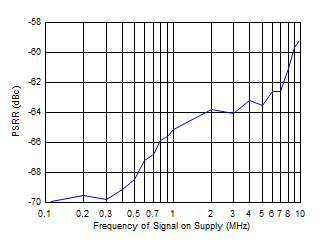
| 32-input mode, 14-bit resolution, fSAMP = 32.5 MSPS, 100-mVPP tone on supply | ||
Frequency of Signal on Supply
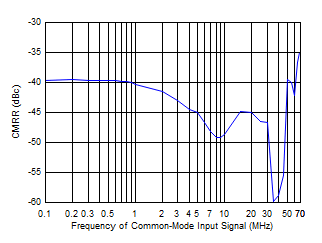
| 32-input mode, 14-bit resolution, fSAMP = 32.5 MSPS, 50-mVPP common-mode tone applied at the inputs, output tone referred to the input tone |
Frequency of Common-Mode Input Signal
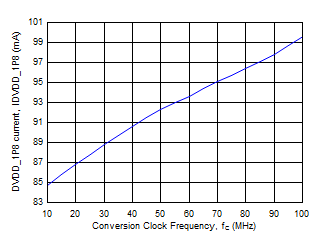
| 32-input mode, 10-bit resolution |
Conversion Clock Frequency
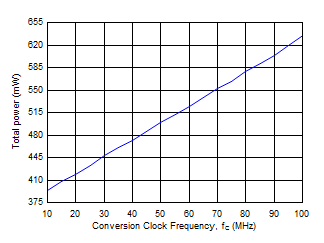
| 32-input mode, 10-bit resolution |
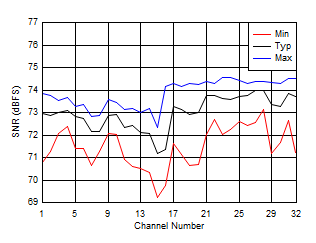
| Statistical values taken over 100 devices in 14-bit, 32-input mode at fSAMP = 32.5 MSPS |
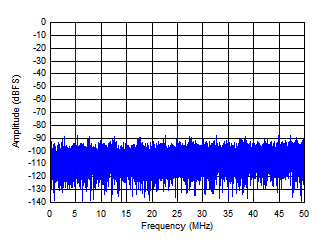
| fIN = 5 MHz, fC = 100 MSPS, SNR = 61.6 dBFS,
SFDR = 78.7 dBc, HD2 = –97.6 dBc, HD3 = –92.2 dBc |
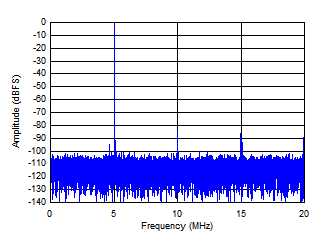
| fIN = 5 MHz, fC = 80 MSPS, SNR = 69.9 dBFS, SFDR = 82.6 dBc, HD2 = –82.6 dBc, HD3 = –88.9 dBc |
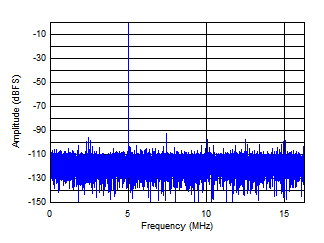
| fIN = 5 MHz, fC = 65 MSPS, SNR = 73.7 dBFS, SFDR = 91.8 dBc, HD2 = –96.6 dBc, HD3 = –97.2 dBc |
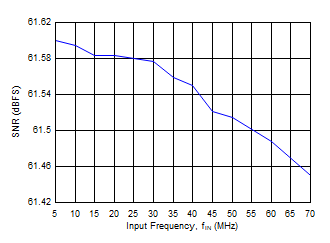
| fSAMP = 50 MSPS | ||
10-Bit, 32-Input Mode
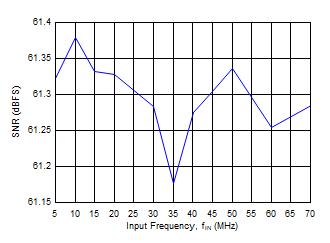
| fSAMP = 200 MSPS |
10-Bit, 8-Input Mode
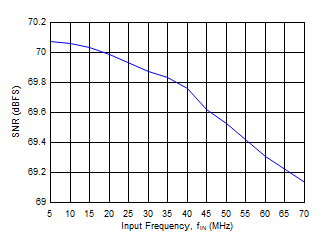
| fSAMP = 80 MSPS |
12-Bit, 16-Input Mode
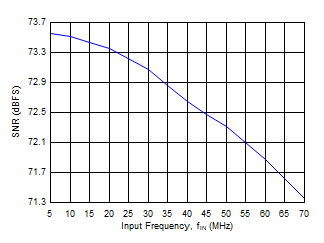
| fSAMP = 65 MSPS |
14-Bit, 16-Input Mode
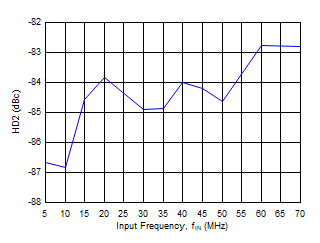
| 100-MSPS conversion clock |
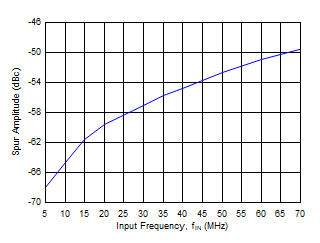
| fSAMP = 200 MSPS |
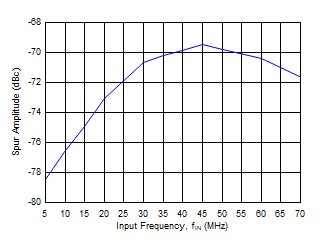
| fSAMP = 200 MSPS |
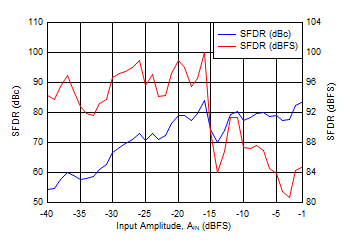
| 32-input mode, 14-bit resolution, fSAMP = 32.5 MSPS |
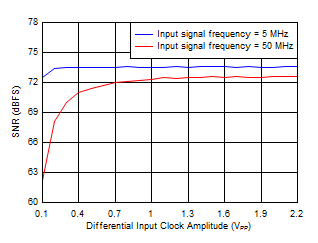
| 16-input mode, 14-bit resolution, fSAMP = 65 MSPS |
Differential Sine-Wave Input Clock
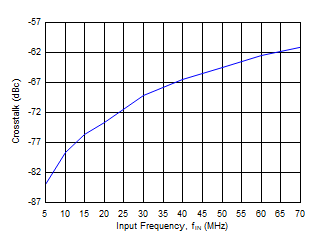
| 32-input mode, 14-bit resolution, fSAMP = 32.5 MSPS, –1-dBFS tone applied on one channel and spur on neighboring channel measured as crosstalk | ||
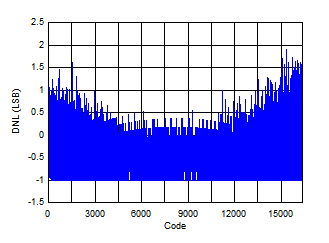
| 32-input mode, 14-bit resolution, fSAMP = 32.5 MSPS |
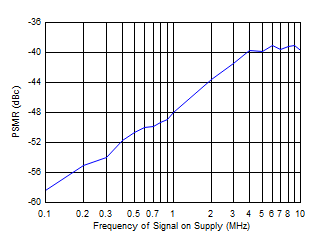
| 32-input mode; 14-bit resolution; fSAMP = 32.5 MSPS; 100-mVPP tone on supply; 5-MHz, –1-dBFS tone on input; PSMR is intermodulation tone referred to input tone amplitude |
Frequency of Signal on Supply
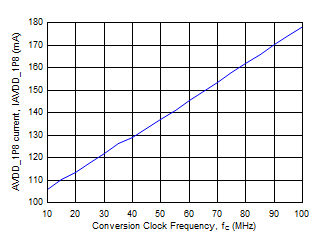
| 32-input mode, 10-bit resolution | ||
Conversion Clock Frequency
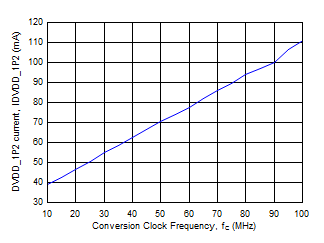
| 32-input mode, 10-bit resolution |
Conversion Clock Frequency
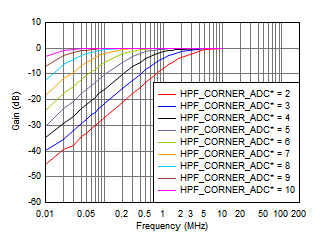
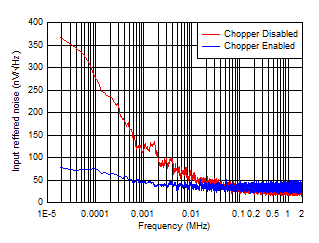
| 16-input mode, 12-bit resolution | ||
Chopper Enabled